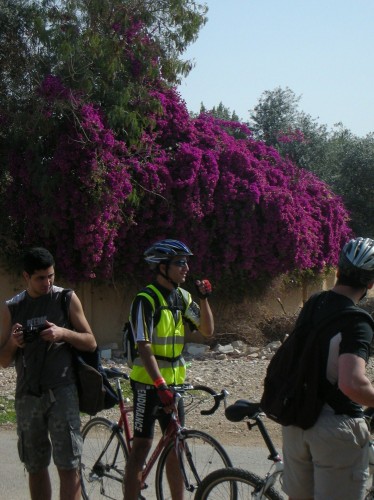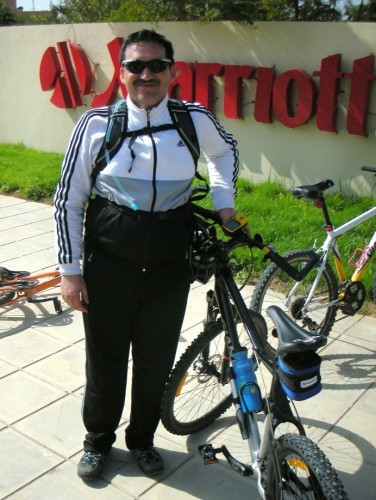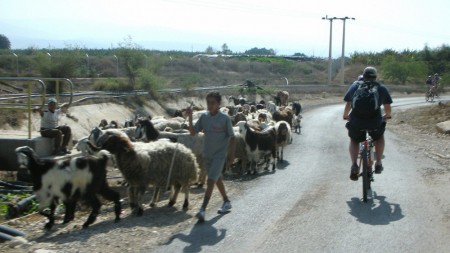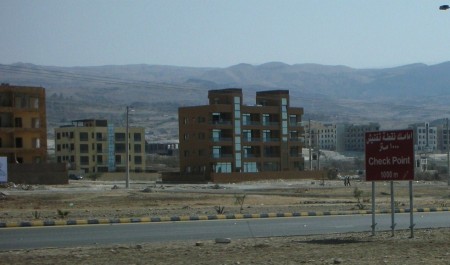I remember when I first arrived in Jordan, watched the cars careening each other madly on the streets of Amman for about 2 minutes, and then promptly said, “well, at least I’m not biking here.” Five and a half months later, it would seem like I’m about to change my mind, for what is hopefully to the benefit of my health and not its detriment. Today I began the month-long training leading up to the Dead-to-Red Relay, the 252 kilometer journey from the southernmost part of the Dead Sea over the hills and wadis (valleys) of the desert to Aquaba on the edge of the Red Sea.
Thanks to recommendations from my colleagues, I was introduced to Cycling Jordan, (as much as I hate giving Facebook the traffic, it seems they don’t keep their real website up to date at all anymore) a little bike shop and club on the other side of town. I had been looking for a group to do the Dead-to-Red with for quite awhile, and for JD25, the proprietor, Sa’ad, told me that he could provide the bike, the team, and the support transportation. It seemed like a good deal to me, and asked him if there was any “practices” going on for it. I was told that every Friday, the biking club took a trip somewhere into the regions around Amman, dropped off a swarm of bikers, and then rode around for several hours, provided lunch, and then took everyone back again. I figured that before I blissfully remounted a bike for the relay in mid-March, I would probably want to remember how to ride one.
I arrived promptly at 8:30 this morning, half an hour early (I operate on German time, not Arab time) and before most of the others had arrived. There was only two other people there at that time, an American and (ironically) a German who had come from his embassy. I milled about, bought a couple liters of water, was served sweet coffee by a smiling, slender young woman wearing a hijab, full tracksuit, and oddly enough, a tank of Nescafe on her back. As more people started to arrive, I saw that most of them were Americans from the universities and NGO’s that dot Amman’s cityscape, and struck up conversations with many of them. Many of them looked rather nervous and, well, jadeed (new) and I suddenly felt like an old hand at living abroad. I talked with several other new Germans who had only arrived in Amman a week ago, and a Syrian-Jordanian who had spent the last year in the UK working. In general, the entire group was multicultural and most of them spoke at least passable English. Sa’ad and his employees, all of whom were about my age, bustled about filling out waivers, directing bikes to be lifted onto the roofs of the bright orange buses that had suddenly appeared outside the shop, and greeting long-time customers. Sa’ad briefly appeared at my elbow, tapped me on the arm, and directed me towards a man wearing dark shades and a full black and white bike suit, including a water tank on his back with a hose going to his mouth. “This is Luay,” Sa’ad introduced me. “If you both feel like it’s a good match, he will be your team leader for the Dead-to-Red.” I only had time to greet him briefly, but as people began to enter the tiny buses I lost track of the man.
The plan was for our group of about 50 bikers to carried to the southwest to the village of Shoona, where Cycling Jordan had a small farm with drinks and more bikes. Then we’d head south to the Dead Sea, and follow its shoreline until we reached the Marriott, then the buses would take us back to Shoona for lunch, and then return to Amman with us. Although the bus ride was only 45 minutes long, the 2 liters of water in my stomach caused me to dash in distress to the bathroom in the little farm before the bus came to a complete stop.

Group leader Sufi’en stands in front of a massive wall of purple flowers. Sometimes you can forget that most of Jordan is a desert
When I emerged, the best and tallest bikes had already been chosen. I surveyed with wry irony the “Giant” brand mountain bike that was before me, and pulled the seat up as high as I could before trying to jam my 1.9m frame onto it. I had an amused flashback to a year and a half ago in Salisbury in southern England while I was trying to find Stonehenge, a stranger in a strange land in which the exact same thing had happened. To my advantage this time, however, Cycling Jordan’s bike was a little bigger and much better kept. As everyone pulled on battered helmets and yanked bottles of water from the sacks that Sa’ad brought out, bikers began to whiz around the driveway to the small, ornate, and almost Latin-looking farmhouse. The sun was warm, the smell of salt just barely hinted on the nostrils, and we were surrounded by huge, heavy purple and red flowers that seemed to coat building walls with swaths of color. After weeks in the gray-brown city of Amman in which colored buildings are so rare, it was bright and garish enough to almost give me a color-induced seizure.
Sa’ad and his colleagues called us to the front of the driveway, gave us some safety instructions, and then suddenly we were off, at first all jammed together and struggling to maintain our balance on tiny bikes (I certainly wasn’t the only one wobbling a little), but then steadily becoming more sure of ourselves and spreading out. The yellow jacketed leaders weaved among us at fore and aft, making sure that everyone was doing okay, and a small cloud of dust followed our knotted presence. Within a couple minutes, we had reached a small highway, and rode parallel to a massive drainage ditch for a few minutes on a narrow ridge. Several of us got off our bikes and walked them until we reached a tiny bridge to the road; no one was interested in a misstep and falling 3 meters down onto the concrete.
We only stayed on that road for a few minutes (cars honking angrily at us, then roaring past us with brakes and rap music squealing) before turning right suddenly into what I thought was a solid wall of banana trees. Instead of crunching against hard gnarled bark, I found myself whirring along a little paved farm road with banana trees and palms on either side of me. By this point the group had spread out a little bit more, and I edged to the front of the group as best as I could without falling into the ever-present drainage ditch to our left.
I really couldn’t have asked for more perfect weather. Even though it was only about 10:30 in the morning, it was already sunny and warm, and almost completely silent except for the clicking of gears and the steady whack-whack-whack noise of the motors of unseen water pumps in the fields around us. We certainly saw the piping from the pumps though; everywhere along the edges of the road and the side tracks from it, there were 8 inch diameter pipes running along the ground with tangles and coils of smaller pipes like capillaries branching off from them. Although the ground was still dusty and sandy and the mountains far to the east were as bare and rocky as anything else in Jordan, the creeping spread of green life covered the sand and filled the air with moisture. At one point as we crossed under a bridge, I heard the sound of a waterfall in the distance. It was like being in a different country.
Biking along the farm road took about half an hour, but then we emerged onto a highway filled with buzzing sedans, semis, and farm trucks carrying goats and camels. We held up for a while there, waiting for the group to catch up a little more. Sufi’en wheeled up to us on his gleaming red touring bike and gazed down the highway to the west, his eyes invisible behind iridescent glasses. “So when should we turn off this road?” I asked him, hoping to get away from the traffic again. He grinned and shook his head. “It’s a straightaway. You’ll know when to stop. Just bike til you hit Palestine.”
We hit the road again, using the completely flat straightaway to build up some great speed, even on mountain bikes. Families passed us constantly on the left, heading towards the dead sea, and the young children stretched their arms from the windows, cheering with glee at the relatively unusual site of bikers on the highway. I was taking pictures constantly and steering with one hand (sorry, mom) and the kids would see my camera and shout “Suer! Suer!” which means “picture,” and I cheerfully obliged. Cars covered with Jordanian flags and filled with young men shot past, honking, cheering, and clapping. Although the shoulder of the road was wide as an entire lane, it was unfortunately being used as a parking lot by picnicking families, leaving their cars there and going down into the trees at the side of the road to have little bonfires, roast lamb kebabs, and sit in the shade. The vehicles in the shoulder meant that we constantly had to dodge in and out into traffic to avoid being victims of parked cars.
At the head of the pack, I found the place that Sufi’en was referring to, where the road turned into a triangle and divided into the path north, to Jesus’s baptismal site on the Jordan River, and south towards the Sea. I realized that this was the exact road that I had gone down with Rana a week earlier on the way to the Marriott. The road in front of me, the one that goes to Jerusalem, was visible for the first time in daylight, and I looked down it until it vanished into a dot at the base of the Sinai-Palestine mountain range.
It took about an hour to make it from the triangle to the Marriott, but because of the wide shoulder and beautiful weather, it was no problem and we took our time. All around us families were camping out, ice cream trucks, farmers selling camel rides to the city people, and kids playing sand football. Everyone waved and shouted “Halla Halla!” which is a typical friendly greeting here, and if I called out “Salaamu Alaykuum” to a seated family, I was always given a chorus of “Wa Alaykuum Salaam” in return, and the children ran out to the edge of the road, jumping up and down and waving.
We passed through a newer town on the northernmost edge of the Dead Sea as the road continued its descent down below sea level. This “newer town” was a reminder of the lack of credit in typical Arab culture. Houses here are almost never built all at once, unless the owner is extremely wealthy, because housing loans are almost nonexistent. When someone wants to build a house or apartment complex, they build it a room or a wall at a time, saving the windows and mortar for last. It often takes years, and the family will just live somewhere else or with friends, moving in slowly as one room after another gets completed. This building style gives apartments and houses an eerie, bombed-out look, but in fact it’s quite normal and completely expected. As you can see from that sign in the picture, a moment afterward we came to a checkpoint with a Humvee mounted with a huge machine gun, guarded by several soldiers who eyed us curiously.
 You may recall that the plan after reaching the Marriott parking lot was to pack up the bikes, and return by bus to the farm from which we had started. However, Luay appeared again, resplendent in his gleaming white and black suit, and asked if I wanted to return to the farm by bicycle with him. He told me that he had met up with us at the triangle. “You didn’t come with us from the farm?” I asked him. He replied that in fact he had biked from Cycling Jordan directly to the triangle and waited for us to catch up with him there, a distance of about 50 kilometers. He barely looked out of breath.
You may recall that the plan after reaching the Marriott parking lot was to pack up the bikes, and return by bus to the farm from which we had started. However, Luay appeared again, resplendent in his gleaming white and black suit, and asked if I wanted to return to the farm by bicycle with him. He told me that he had met up with us at the triangle. “You didn’t come with us from the farm?” I asked him. He replied that in fact he had biked from Cycling Jordan directly to the triangle and waited for us to catch up with him there, a distance of about 50 kilometers. He barely looked out of breath.
My un-giant Giant bike had already been packed up and was somewhere on the roof of one of the buses. Sufi’en didn’t even hesitate before offering me the use of his shining new touring bike instead. It took me a few minutes to get used to the dropped handlebars on the bike, and I circled around the parking lot as the buses pulled out with everyone else, leaving Luay and I alone to begin the trip back to the farm. We biked slowly most of the time, chatting about politics, computers, and technology, as well as his field of civil infrastructure engineering. It turned out he was from Iraq, and had only come to Jordan a couple years ago from Baghdad, when the danger there grew too great for his family.
At the triangle, we continued to go north, instead of turning east to retrace our path. Traffic continued to be light, but the number of tourist shops and souvenir shops bearing signs for “Holy Water Here” increased exponentially. We got some drinks at a small shop and downed them in the shade by the side of the road, joining the dozens of families on spread picnic blankets all around us. I was having some difficulty with my back and staying so low on Sufi’en’s bike, so Luay and I traded and I used his big mountain bike, which although slower than a touring bike, was vastly more comfortable for me. His yellow GPS device plotted our course perfectly and he told me that I was no responsible for finding our way back to the farm! We were only a few kilometers away at this point though, and in another half an hour we were back in the banana plantations again.
The buses had long since taken everyone else back to Amman, so the only people left at the farm were the young Cycling Jordan employees, waiting for Luay and I to make sure we made it back okay. They made tea for us, and we all sat around the swimming pool in the backyard, Luay and I dipping our legs into it and feeling the burn in our muscles. Then we packed up Sa’ad’s pickup truck with the last bike, and drove back to Amman. Luay and I had become good friends during our hours together, and he took me to his home in Rabia, where I met his family and had some snacks. Both he and I were extremely hungry (having missed the lunch that everyone else on the trip received) so he took his 5 year old son Zain and I to an Iraqi kebab restaurant nearby where we could finally eat our fill. Zain amused himself with pieces of paper and the napkins, picking them up to watch how they floated and drifted towards the ground. Luay looked at him lovingly and I told him that his son was destined to be an aerospace and aircraft engineer in the footsteps of his father.
In all, it was one of my best days and favorite trips since I’ve gotten to Jordan, and the JD15 was definitely worth it to make so many new friends and get out of Amman. I definitely plan on buying a bicycle of my own from Cycling Jordan as soon as possible (specifically, one that fits me) and some biking clothes. After 4 hours on a bicycle seat while wearing jean shorts, my rump is quite sore and I can barely walk without falling over. But I still have over a month until the Dead-to-Red, so I feel like I’ll be more than ready by then. After all, there’s a reason why they say it’s “like riding a bicycle”!




Hey, its good to know you enjoyed your time and made new friends, I am glad that we have introduced you to cycling in Jordan … Keep pedalling!
I am somewhat jealous. The roads finally cleared up enough for me to take out my hybrid on Friday, but now it’s gotten gloomy and there are patches of ice in spots. Probably still another month until I can get out the road bike.